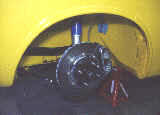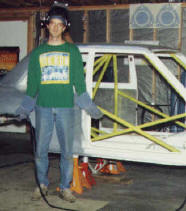The Story
This is the story of my 1969 2-door Datsun 510. I have been working on this car for many years! Back in the late 1980's Turbo Tom was nice enough to give me one of his old race cars for a very fair price in a trade. It was an IMSA-RS car that was in great condition. It was pretty much stripped, and it had a roll cage suitable for a truck, but it was an early 2-door with a very nice, clean chassis and body.
|
|
|
I held on to the car for about a year before I started doing any work on it. During that time I came up with some pretty extreme plans for it, and as the car came together, the plans grew even more elaborate.
My design goal for this car was simple: make the quickest possible streetable 510. That's it. Quickness is first and last, it must permeate the car, but the word streetable is in there too: it must be easy to drive on the road. I tried to maximize the power-to-weight ratio, but most of my efforts were in weight reduction rather than power. For this car, light weight "outweighs" high power, because power doesn’t help a car corner or stop. Compromises are in favor of torque versus horsepower, in acceleration versus top speed, and in cornering and braking vs. straight-line speed, since this is a street car.
At the outset, I knew I wanted a turbocharged rotary engine and a narrowed Jaguar rear suspension. I also decided to make all modifications to high standards and to produce a show quality vehicle.
Here are the main steps in completing this car:
- Build the car
- Drive and adjust it until everything works satisfactorily
- Disassemble and paint the car, and detail the parts
- Reassemble the car and continue driving it
Building a project car like this, be it a street or race car, is an interesting experience. If you’re a perfectionist like me, it can be perplexing. Compromises have to be made when designing things, and often the problem is that I don’t have enough information/experience to make as educated of a decision as I would like to. On top of that, it’s amazing how many things don’t work out as originally planned, no matter how carefully you think you planned. And changes that you make affect other work that you had already completed.
It took me a long time to get the car running because I am a perfectionist, and because I kept coming up with new and better ideas of what I wanted. I still remember the day that I finally fired up the engine for the first time. The exhaust system was not complete yet, and there was no muffler. Those familiar with rotary engines know how loud they are, and I was expecting a real racket. But the turbocharger helped a lot to keep it reasonably quiet, and it actually sounded quite incredible. I was tempted to leave off the muffler (more weight savings, right?) but eventually decided on a two-chamber Flowmaster. At first the engine smoked due to being unused for many years. People familiar with rotary engines told me that the smoke may clear up after a few engine heat cycles and luckily it did! The rotors have side seals that keep oil out of the combustion chambers. Maybe they had to "break in" again.
Getting the car from running to driving was a lot of work, but I just kept plugging away and crossing items off the list (while adding more to the bottom at the same time). I tried to take my time and not take any shortcuts. I knew that I would be taking the whole car back apart so I wasn't too concerned about detailing the parts but I did want them to be mechanically finished.
Finally I finished the front and rear suspension, brakes, and so forth and was able to drive the car. I drove the car slowly and carefully at first, a little bit and everything seemed OK. Then I gradually drove it a little harder and "a little" faster. I was surprised that everything seemed as good as it did right "out of the box". I did make a few suspension and alignment adjustments. The steering didn't feel that great but that didn't surprise me. There were also lots of rattles that I made note of, so that I could address them upon final assembly after painting the car.
I didn't quite manage to meet the four-step goal. I had been waiting for a friend of mine named Tony that owned a body shop to paint the car. He has done some cars that were stunning, including three of his own 510's, and I knew he was the right person to do the body work and paint to this car. Suddenly one day he called me and said he would be ready in about a week! I wasn't really ready to take the car back apart, but I knew if I didn't I might have to wait a long time for him to have another opportunity to work on my car. So, the car would be disassembled, painted, and reassembled before a lot of adjustments and tuning were completed. I got right to work taking the car apart and actually had it completely disassembled in no time. Tony told me to leave all body parts on (doors etc.) so I did not remove those. I made a dolly so the car would sit up high and could be rolled around the shop.
While the car was away at the paint shop I was hard at work detailing all the parts. I kept the local powder coating place busy for weeks. (Most parts I had done in gloss black, and I had the exhaust pieces ceramic coated and polished.)



Reassembling the car was of course a big job and I was very careful not to scratch any
paint! I installed the engine and transmission in one piece from the underside of the car.
No need to even remove the hood! Filling and bleeding the brake and clutch system with the
under-dash master cylinders was a little scary but I was very careful and didn't spill any
brake fluid.
While reassembling the car I decided the weakest link was the steering. I decided to convert to a rack and pinion.
Some of the items I have not finished yet for this 510 include:
- Rear side windows: I got some .090" lexan sheets and now need to make some aluminum frames for the windows, have them powder coated, and cut the lexan panels.
- A few more interior panels need to be made, probably from carbon fiber.
Once I complete these items, this car will be essentially finished as far as fabrication and construction. Of course there is a lot of development to be done. The only additional work to be done would be to replace a few parts with lighter-weight, but much more expensive items. See the design philosophy page and the chassis page for details.



